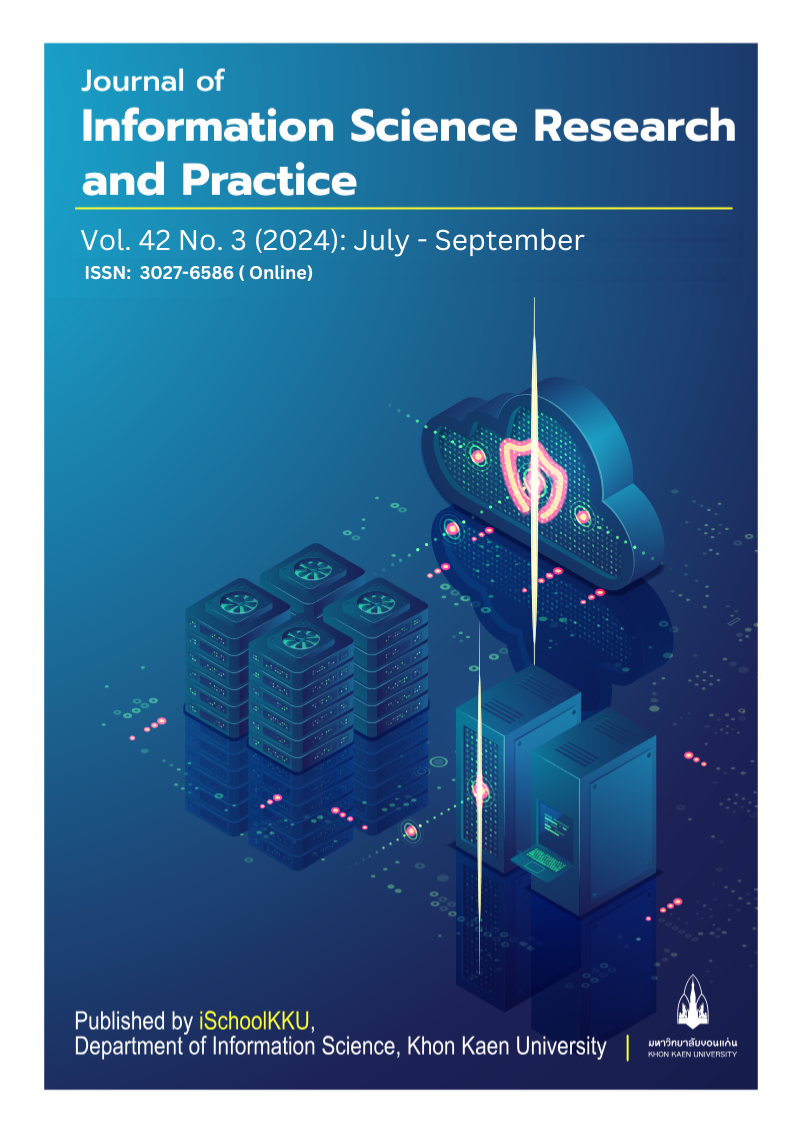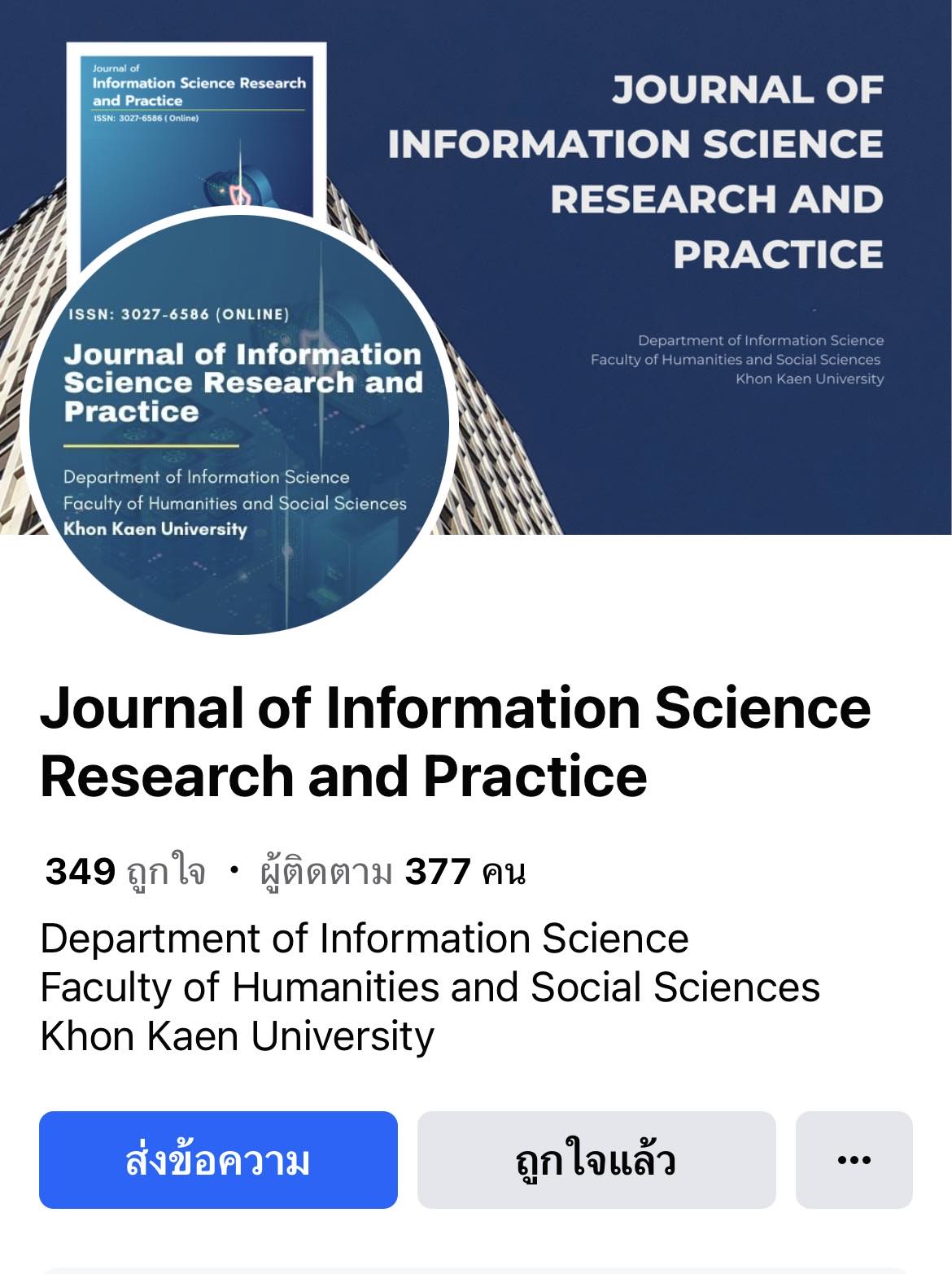Social Media Literacy Level of the Elderly in Muang District, Chiang Mai Province
DOI:
https://doi.org/10.14456/jiskku.2024.20Keywords:
Elderly, Social Media, Social Media LiteracyAbstract
Purpose: This study examines the behavior and social media literacy level of the elderly in Muang District, Chiang Mai Province.
Methodology: This research used a quantitative method, using a questionnaire to collect data from 381 elderly people aged 60 years and over in Mueang District, Chiang Mai Province.
Findings:
The study results revealed that elderly people most frequently use social media in the morning, primarily through smartphones. They mainly use social media for communication, with YouTube being the most popular platform. The primary issue faced by the elderly in using social media is blurred vision, often due to deteriorating eyesight. The assessment of social media literacy among the elderly in Chiang Mai Province found that, overall, it is at a moderate level. The components with the highest average scores, indicating a high level of literacy, were element 2: analytical skills, and element 4: creative skills. Following these, at a moderate level, were element 3: media evaluation skills, element 5: participation skills, and element 1: accessibility skills
Applications of this study: The findings from this study can serve as a guideline for relevant agencies, such as the Chiang Mai Provincial Social Development and Human Security Office, public libraries, the Division of Social Welfare of Chiang Mai Municipality, and other subdistrict municipalities located in Mueang District. The focus should be on improving the skills identified as having the lowest average levels of social media literacy among the elderly. Additionally, it is recommended to use media to highlight the challenges faced by the elderly when using social media. This approach will help enhance their resilience to social media and future technologies.
Downloads
References
Akkaprasa, P. (2014). Media literacy concepts and theories. Bangkok: Office of Consumer Protection in Broadcasting and Television Business.
ASEAN Learning Center Department of Local Administration Promotion. (2016). List of subdistricts, districts, provinces. Retrieved from http://asean.dla.go.th/public/glossary.do?type=12&cmd=list2&lang=th&random=1572627110964
Best, J. W. (1977). Research in Education. Englewood Cliffs, N.J.: Prentice-Hall.
Chanthorn, P. (2013). Internet access for the elderly in Na Pradu Subdistrict Chonburi Province. (In Thai). Master’s thesis, Ramkhamhaeng University.
Department of Older Persons. (2018). Statistics on the number of elderly people in Thailand 2017. (In Thai). Bangkok: Department of Provincial Administration.
Department of Older Persons. (2019). Statistics on the number of elderly people in Thailand 2018 by Power Bi system. (In Thai). Bangkok: Department of Provincial Administration.
Department of Older Persons. (2020). Elderly statistics as of February 28, 2019 Separated by sub-district. (In Thai). Bangkok: Department of Provincial Administration.
Ebel, R. L. (1972). Essentials of educational measurement. Prentice-Hall Inc.: Prentice-Hall International.
Ekaphokwat, M. (n.d.). Creative use of social media. (In Thai). Bangkok: The Secretariat of the House of Representatives
Hanumas, M. & Parnnuch, P. (2023). Media exposure and media literacy skills among elderly in Suratthani province. Journal of Social Science and Cultural, 7(12), 318–329.
Kaewthep, K (1998). Mass communication theories and educational approaches. Faculty of Communication Arts Bangkok: Chulalongkorn University.
Kleechaya, P. (2020). Thai People’s Engagement, Risk from Social Media and Competence in Digital Intelligence and Literacy. Journal of Communication Arts, 38(3), 1–16.
Krejcie, R. V., & Morgan, D. W. (1970). Determining sample size for research activities. Educational and Psychological Measurement, 30(3), 607–610. https://doi.org/10.1177/001316447003000308
Kucharoensin, S. (2015). Media use of the elderly living in Amphoe Muang in Chonburi Province. Journal of Education and Social Development, 11(2), 270-281
Likert, R. (1932). A technique for the measurement of attitude. Archives of Psychology, 140, 1-55
Meksrithongkam, B. & Singsangob, A. (2009). The situation of using the internet media of Thai children and youth at various stages of age development. Bangkok: Bangkok University.
National Economic and Social Development Plan No. 13 (2023 - 2027). (1 November 2022). Royal Gazette Volume 139, Special Chapter 258.
National Statistical Office. (2017). Revealing the results of the survey of the elderly population in Thailand 2017. Bangkok Forecasting Statistics Division National Statistical Office.
National Statistical Office. (2020). Summary of important reasons: Survey of the use of information and communication technology in households in 2020. Bangkok Forecasting Statistics Division National Statistical Office.
Prachanban, P. & Kornpuang, A. (2016). (2016). The research and development of the measurement instruments of the media literacy skills in the 21st century for secondary students. Journal of Education and Innovation, 18(1), 144–154.
Rueangyot, C. & Choompolsathien, A. (2022). Social Media Literacy Among the Elderly. Media and Communication Inuiry. 4(1), 144 - 169
Silverblatt, A. (1995). Media literacy: Key to interpreting media messages. Westport, CT: Praeger.
Sirithai, N. (2004). Knowledge about media literacy for health, immunity, and good health for children and youth” in the development of health media literacy knowledge into the curriculum in the system and outside the Thai education system. Bangkok: ThaiHealth.
Siriwong, P. & Unhalekjit, B. (2017). Social media use of the elderly in the market area of Sam Phran Subdistrict, Sam Phran District, Nakhon Pathom Province. (In Thai). Research report, Silpakorn University.
Somsuk, S. (2022). Social Media Usage Behavior of the Elderly. Praichart Journal, 30(1), 62-77
Vichitrboonyaruk, P. (2011). Social Media: Future Media. Executive Journal, 31(4), 99-103.
Virojtrairatt. U. (1997). An analysis of media literacy levels of higher education students in Thailand. (In Thai). Doctoral dissertation in Educational Technology and Communication, Chulalongkorn University.
Yenchabok, P. (2009). thotrahat lap khwamkhit phua kan ruthao than su [Decode the secret concepts for media literacy]. (In Thai) Bangkok: Offset Creation Co., LTD.








